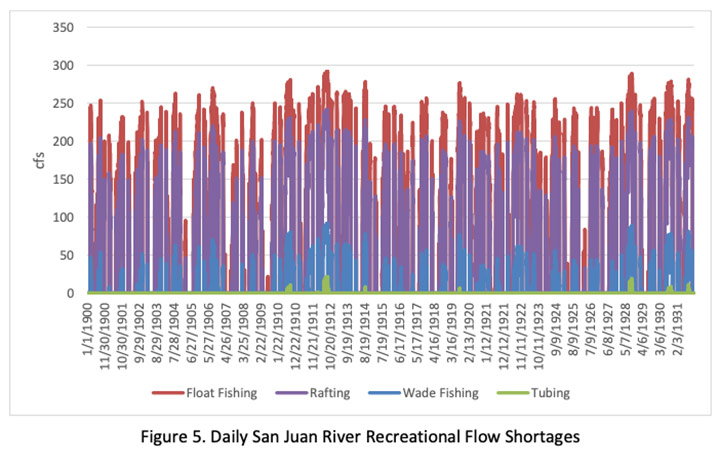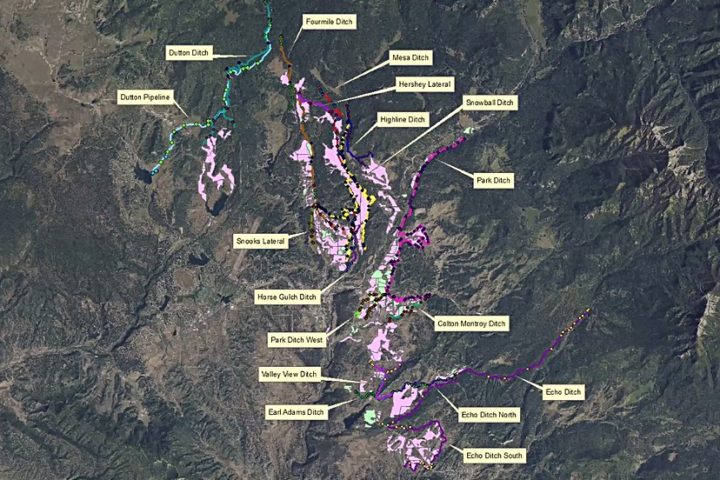Wilson Water Group completed an analysis of current and future water supply and demand through 2050 in the Upper San Juan River basin for the San Juan Water Conservancy District…
— from the ‘San Juan Water Supply and Demand Analysis’ by Brenna Mefford and Erin Wilson, July 19, 2022.
The presentation of a “Draft Memorandum” from the Wilson Water Group (WWG) to the San Juan Water Conservancy District on Monday was met by a number of excellent questions coming from the newly-expanded SJWCD board of directors, and from the public.
If all goes as planned, the general public will be able to experience a similar presentation on August 9, courtesy of SJWCD. (Time and place TBA).
Wilson Water Group had been tasked with estimating something that’s impossible to estimate accurately — namely, how much water will the Archuleta County community needs to keep them alive and happy in the year 2050?
With the emphasis on “happy”, considering that humans have somehow managed to stay alive in the Pagosa Springs area for maybe 10,000 years? Since the end of the last Ice Age?
“Happy” is more intellectually challenging than “alive.”
In the case of ‘water demand’, we are concerned mainly with the happiness of five (sometimes overlapping) groups.
1. The people who use treated drinking water supplied by Pagosa Area Water and Sanitation District (PAWSD), and who pay fees and taxes for the privilege.
2. The people who grow grass using free irrigation water, and feed it to cattle or sheep… either as a business, or as an excuse for paying Colorado’s notoriously low ‘agricultural’ property taxes.
3. The people who raft or boat or tube in — or fish in — the San Juan River.
4. The people who want to see our natural environment preserved to the greatest extent possible, including the San Juan River.
5. The people who play golf at the Pagosa Springs Golf Course.
The first four groups, listed above, were included in WWG’s report. The golfers somehow escaped mention.
As readers of this editorial series may have already discerned, I was not happy with the ‘San Juan Water Supply and Demand Analysis’. I’ve been researching and writing about water supplies and water uses in Archuleta County, off and on, since 2008, and I have several issues with WWG’s approach to estimating ‘municipal water’ and ‘agricultural water.’ Specifically, my unhappiness was related to inaccurate data, and the way that inaccurate data was used in calculations.
Predictions about 30 years in the future are inherently inaccurate. But that’s no reason to treat existing data in a sloppy manner.
I was also unhappy with WWG’s half-baked treatment of ‘agricultural demand’. I shared some of my concerns with WWG presenter Erin Wilson, and with the SJWCD board, on Monday.
Disclosure: I currently serve on the Pagosa Area Water and Sanitation District (PAWSD) board of directors, but this editorial reflects only my own personal opinions, and not necessarily those the PAWSD board as a whole.
I was disappointed that the $15,000, 24-page report spent 2,200 words, and 10 colorful charts, discussing “E&R” (Environmental & Recreational) water demands…
…and only 1,450 words, and one chart, discussing municipal demands…
…and only 360 words, and one chart, discussing agricultural demands.
The cursory discussion about agriculture, I found especially unfortunate, considering that agriculture consumes about 94% of the water diverted in Archuleta County. If any water demand in Archuleta County deserves a better understanding, it’s agricultural water. In my humble opinion.
As mentioned, several board members and members of the public commented on, or raised questions about, the ‘San Juan Water Supply and Demand Analysis’ at Monday’s meeting.
One member of the public who raised questions was Mely Whiting, who has been an active participant in the Upper San Juan River Watershed Enhancement Partnership (WEP) — a research team sponsored by Durango-based Mountain Studies Institute that has been developing a “Stream Management Plan”.
The 2021 ‘Phase II’ report from the WEP is available at the Mountain Studies website, here.
Ms. Whiting understood — as all of us did — that the aim of the Wilson Water Group report was to help define a size for a potential water reservoir in the Dry Gulch valley.
The word “reservoir” features prominently in the WWG report conclusions, but does not appear anywhere in the WEP Phase II analysis.
Ms. Whiting:
“You know, reservoirs are expensive. They can have significant impacts, even if you do release some water for flushing [river sediment]. You’re still having an impact on the health of the river, and you’re having an impact in general. So I think it merits looking — are there any other options?
“And frankly, the cost, to me, is the most prohibitive thing of all. The cost of trying to get something like that built…”
Wilson Water Group was not asked to look at alternative approaches to future community water ‘shortages’, nor were they asked to estimate the cost of a Dry Gulch Reservoir.
Ideally, a “Stream Management Plan” brings together all of the five community sectors I mentioned above — municipal users, agricultural users, recreationists, environmentalists, and even golfers — to collaborate on an overall plan for the community’s available water resources. A ‘cooperative’ plan, in other words.
Over the past three years, the WEP has attempted to get our whole community involved in the creation of the “Stream Management Plan” with limited success. The meetings I have attended have been dominated by recreationists and environmentalists, and government employees, with very little representation from the agricultural community.
But with the help of the San Juan Conservation District… (not to be confused with the San Juan Water Conservancy District)… connections were made with certain agricultural users, and a study was performed of some of our agricultural ditches and was included in the WEP Phase II report.
Ms. Whiting:
“I would very much appreciate WEP being able to look at the [Wilson Water Group] report. I’m very concerned about the potential use of the recreational and environmental flows analyses [in the Phase II study] to justify building a reservoir to provide those flows, because those analyses were not done in a vacuum. The whole context of the WEP process was to come up with potential projects, potential ways to address needs in a cooperative manner.
“WEP did not put that report together with a reservoir in mind. A reservoir has so many other implications, so many other impacts, that perhaps having a little water to meet some of that demand is really not that important, in the balance of things. You end up with more impacts to recreation, more impacts to the environment, if you do [build a reservoir]…
“I would love for the WEP members to be able to review the report…”
You can download the WWG draft report here, if you haven’t already. And I’ll again mention that a presentation of the Wilson Water Group report is scheduled to be given for the general public on August 9, courtesy of SJWCD. (Time and place TBA).


